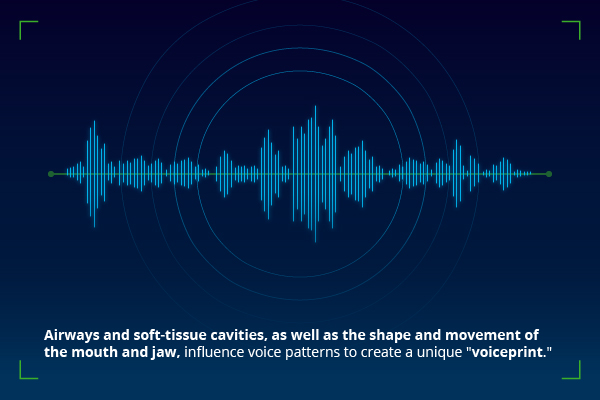Biometric authentication, unlike passwords or token-based authentication, uses unique biological characteristics to verify an individual’s identity. It’s harder to spoof and generally more convenient for users since they don’t have to remember passwords or carry a physical token that can easily be lost or stolen. The authenticator is part of the individual.

Voice recognition (also called speaker recognition or voice authentication) applies analyzes of a person’s voice to verify their identity. Airways and soft-tissue cavities, as well as the shape and movement of the mouth and jaw, influence voice patterns to create a unique “voiceprint.”
Speaker recognition is a type of voice recognition technology. However, it is not the same as speech recognition, which is the technology used in speech-to-text applications and virtual assistants like Siri or Alexa. Speech recognition can make sense of verbal language, but it can’t verify the identity of the speaker based on his or her unique vocal attributes; voice biometrics can.
Speaker recognition methods
There are two main approaches to voice authentication:
- Text independent: Voice authentication is performed using any spoken passphrase or other speech content.
- Text-dependent: The same passphrases are used in enrollment and for verification. This means that a speaker cannot say anything he or she would like to authenticate, but will be asked to speak a predetermined phrase. In static text-dependent voice authentication, the same passphrase is used for every verification. In dynamic text-dependent voice authentication, a randomized passphrase such as a number sequence is generated for the user. This content must also be enrolled.
Enrollment and verification
A voice biometric sample must be captured and enrolled using a microphone to create a reference template to compare against samples for future authentication attempts. Unique vocal qualities are then analyzed;, such as :
- Duration
- Intensity
- Dynamics
- Pitch
Voice authentication use cases
Voice authentication’s primary use case is hands-free mobile authentication. This is ideal for mobile phones or other settings where facial recognition, fingerprint recognition and other forms of biometric authentication are inconvenient, such as. in automobiles.
Voice authentication is also useful for speech-recognition devices such as Google Home or Amazon’s Alexa. Virtual assistants are increasingly used to place orders and perform other functions that typically require some form of authentication.
Speaker recognition can also function as an authenticator during customer-support calls. Users may find this more convenient and secure than sharing personal information such as their license or credit-card number for identity verification.
Advantages and disadvantages
Voice recognition has several key advantages over other forms of identity authentication:
- Widely accessible for authentication on mobile phones given that all phones have microphones.
- Cost-effective to integrate into other devices such as automobiles and home appliances.
- Convenient and familiar for most users.
- Contactless, and therefore less invasive and more hygienic.
- Useful for phone-based use cases such as customer service
Some disadvantages of Voice recognition include the following:
- Not as accurate as other biometric modalities (e.g., facial recognition).
- Requires liveness detection to verify that a sample is from a live speaker and not a recording.
- Background noise can impact the quality of the sample and, in turn, matching performance.
- Not ideal for all environments (e.g., noisy or public spaces).
Aware products for voice authentication
Aware offers the following voice biometrics products:
- Nexa|Voice: Mobile voice authentication SDK.
- Knomi: Mobile biometric authentication framework.
- AwareID: Lightning-fast identity verification, multi-factor authentication and multi-modal biometrics in a single, low-code platform.
Click here to learn more about Aware’s portfolio of voice biometrics products and services.